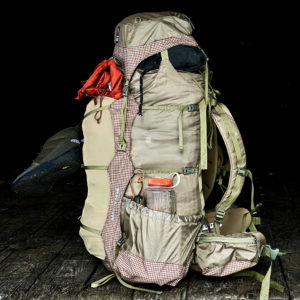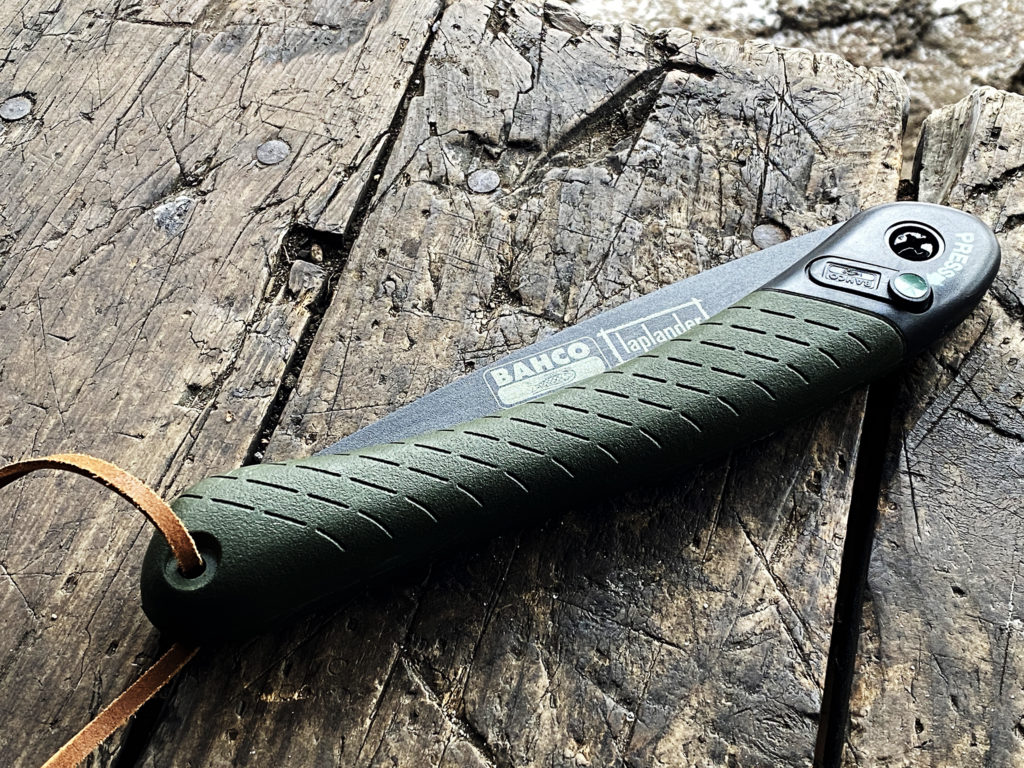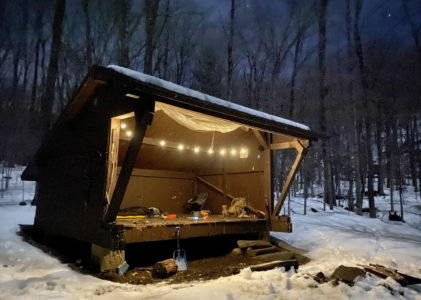For most of my life I’ve been a fair weather camper.
Growing up, a trip to Camp Overflow at Otis Reservoir was a summer staple. For a long time I stuck to that pattern, and treated camping as a getaway option between June and mid-September. But that doesn’t leave a lot of chances to sleep in the woods each year. So with the overnight lows on February 12 finally forecast to stay around or just above 20°, I made a last-minute decision to head out to Monroe State Forest to work on building the skills that would help stretch my camping season.

The forest covers rugged hills along the upper reaches of the Massachusetts stretch of the Deerfield River. It’s home to stands of old growth trees—including a hemlock estimated at 450 years—as well as a trio of Adirondack style shelters that offer a rare chance for backcountry camping without leaving the state or heading to the Appalachian Trail.
Strikingly clear, Dunbar Brook tumbles over boulders as it drops from the upland woods to a hydroelectric facility near its mouth at the Deerfield. The Dunbar Brook Trail near the dam and heads upstream, passing the shelter I’d call home for the night. It’s a short, scenic hike of about 45 minutes, and I got to the site in light that was falling fast. I quickly gathered a stack of firewood, stocked up on water, blazed a path up the hill to the outhouse, and settled in for a long, cold night.
This trip had a lot of firsts. It was my first time camping in sub-freezing temperatures. My first time camping with snow on the ground. My first time sleeping outside with no tent. My first solo camping trip in a location this remote. I did some dumb things—but I also did some things that kept me comfortable and safe. Here’s a recap.
Winter camping mistakes

- Assumed there wouldn’t be snow. We’ve had a cold winter in the Pioneer Valley, but we haven’t seen much precipitation. I expected ice on the trails in northwestern Franklin County, but I didn’t think there’d be enough snow left to warrant snowshoes. I was wrong. Most of the trail was covered in about 6 inches, which is right around the depth where I’d want to switch over from microspikes (which I wore). The hike was short enough to be bearable. But I should’ve at least strapped a pair of snowshoes to my pack.
- Got my feet wet. Getting to the shelter means getting across Haley Brook, which I’ve found to be a little easier said than done. It’s not too wide, but the water is swift and deep in spots, and there aren’t a lot of choice spots for rock hopping. In summer, or when the water’s low, it wouldn’t be a challenge. With temperatures headed below freezing I really wanted to stay dry—but I also didn’t want to bushwhack too far upstream to find one of the narrower crossings I remembered from my last visit. So, maybe inevitably, I mistook an ice shelf for solid ground and my left leg plunged through. The water wasn’t too deep; some went over the top of my boot, but it wasn’t a thorough soaking. I had long underwear to change into for sleeping, as well as extra socks, but still—it was a mistake that could’ve ended the trip early.
- Got my socks even more wet. After collecting firewood I changed into my sleeping socks and camp shoes. When I fired up my stove to boil water for dinner, I put my wet hiking socks nearby, hoping they’d dry out a bit. Maybe that would’ve worked—if I hadn’t knocked over the pot and spilled the leftover hot water from my dinner all over them. They were frozen solid by morning.
- Forgot a carabiner to hang my bear bag. It was getting late and it was time to hang my food for the night. For most of the last year I’ve been using an Ursack AllMitey in conjunction with odor-proof sacks. Just a few simple knots and a carabiner and I can hang the bag at about shoulder height, and save myself the fiasco of trying to chuck a rock over a tree branch. But, surprise: the carabiner I keep in the Ursack specifically so that it’s “always” there… wasn’t there. I improvised with a rusty hacksaw I found hanging on one of the shelter’s walls.
Winter camping wins
- Skipped a tent, but brought a footprint. I knew I wouldn’t get to the site until right around sunset. So, I decided not to mess with trying to pitch a tent, gather firewood, and take care of any other setup before it got dark. I decided I’d sleep right on the floor of the shelter. To protect my sleeping pad, though, I put down my tent’s footprint. Did it make a difference? I don’t know, but it gave me peace of mind. Next time, I’d like to add a closed-cell foam sleeping pad to the system for some added warmth.
- Made a hot water bottle for sleeping. I brought a single water bottle on this trip: a 1.5 liter Nalgene for hydration, meals, and to serve as a toasty companion while I slept. I boiled a pot of water right before bed, filled the bottle and crawled into my sleeping bag. It stayed hot for hours, and when I felt a draft against my back—right along my sleeping bag’s zipper—I moved the bottle to block it.

- Brought a saw. I didn’t have much time to collect firewood, and my Bahco Laplander made it much easier and quicker to process some of the downed limbs around the site.
- Got extra water before dark. I was planning to do at least one water refill from the brook on this trip. At first, I figured I’d do it just before bed. But the slope down to the brook was steep and covered in snow and ice, and I didn’t want to risk putting my foot through another ice shelf while I was trying to find the water’s edge in the dark. So, I filled up my pot right right after I got to camp, used that water for dinner, and still had my full water bottle for the rest of my stay.
- Slept with my boots. I stuffed them in a drybag and tucked them down into the foot of my sleeping bag. That kept them from freezing overnight, and made getting ready for the hike out a little less unpleasant.
- Brought a backup pair of hiking socks. I could’ve stashed my wet socks in the drybag with my boots. But having a fresh, dry pair in the morning was way better.
- Brought camp shoes. I almost didn’t bring a pair of camp shoes, thinking I’d just wear my hiking boots the whole time (and thinking there’d be no way I’d be clumsy enough to get them wet). My Keen Howsers—the chukka boot version—definitely aren’t ultralight, but slipping them on over my thick sleeping socks made for a nice evening by the fire.
- Brought a heavier pillow. I’ve been using a Nemo Fillo Elite Luxury pillow on kayak camping trips to save a little space. But I also have a few of the Fillo’s regular version, which has a layer of memory foam—and that’s what I brought for this trip, despite a much larger packed size and heavier weight. I figured the foam might offer just a little warmth under my head than the Elite version, which is an air pillow only. It’s hard to say if this really made a difference, but I’m calling it a win.
I’ve gotten used to camping trips where the nighttime soundtrack is a chorus of loons and barred owls and critters shuffling through leaves. But the winter woods had a stillness that was as beautiful as it was eerie. With a bright moon a few days from full high overhead, the wind in the trees and the brook’s rushing water created their own kind of silence.
Even though I was warm enough, there were moments when I was convinced I wouldn’t sleep at all. I’m an active sleeper, and the confines of the mummy bag I brought—the only one I had that was warm enough for the forecast—made it tough to stay comfortable. But before I knew it the sky had turned its deep twilight blue. Light snow was falling. I’d made it, and I decided to snooze a little longer. The stretch between about 6:30 and 8 a.m. was the best sleep I got, and only the promise of a hot cup of coffee and a dose of Mountain House biscuits and gravy could coax me out of my cocoon.

